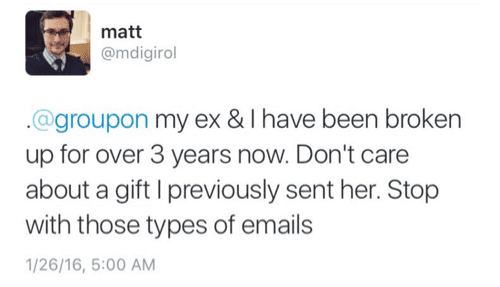Don’t be creepy with your data


3 strategies to ensure you are using customer data ethically and effectively
If your career revolves around selling products on the Internet, you’ve probably had people ask, “How do they know I was looking for a new (insert product here)?”
“They” includes everyone from social networks like Facebook and Twitter to Google (and just about any other website where ads are shown). By using personal data, advertisers are able to create highly targeted ads, which usually either go unnoticed or are only mildly unsettling. Some promotions, however, can come across as full-blown creepy.
People love personalization, so they’re not unnerved by relevant content. The creep factor comes in when they don’t understand how the data is exchanged that powers these sorts of retargeted ad campaigns. People assume that the website showing the repeat ad has access to their search data. In reality, the information is brokered anonymously through third-party cookies.
But the mechanics of data don’t mean much once customers believe sites are up to something shady. They feel they’ve been unmasked in front of strangers who have no right to know their personal business. And while many brands operate ethically, plenty engage in retargeting practices that validate consumers’ privacy fears.
Warranted Skepticism
Some companies exploit an ethical gray area by selling or merging third-party data sets. They match the real names, emails, and home addresses customers provide at physical retail stores to online dating or social profiles. Then, they create cookies based on the information. That’s why someone who buys earrings at a local mall sees online ads from other jewelers shortly thereafter.
Other sites give customer data to sites that receive the same traffic but fewer email sign-ups. Even though the users chose not to give the second site their information, the first exposes them anyway. Most people don’t realize this is happening, and they’d probably be outraged if they did.
Ethical Data Usage
Consumers know that companies market to them based on data, but they expect some measure of privacy and sensitivity. That’s why the story of Target finding out — through machine learning on her purchase data — that a young woman was pregnant before she’d even told her dad made people queasy.
Different consumers have different comfort levels with sharing their information, so companies need to be considerate and respectful in how they use it. Here are three strategies for using data effectively and ethically:
Testing also plays a key factor in knowing whether you’re hitting the right tone with your audience. Running a small, highly targeted campaign with potent messaging tells you far more than generalized strategies. Conversion rates and qualitative feedback through social listening or through the ad network provide useful performance indicators on these campaigns.
HubSpot, for example, studied more than 93,000 calls to action (CTAs), as well as hundreds of millions of views over 12 months. The results showed that targeted CTAs held a 42 percent edge over generalized CTAs in view-to-submission rates. It pays to get specific.
Facebook and some other ad networks allow users to rate sponsored items, which increases ad relevance and gives consumers a sense of control over what they’re seeing. Consider building similar mechanisms into your site so customers understand where your ads come from.
Amazon excels at this. When you visit its homepage, automated recommendations dominate the experience. Amazon’s algorithms recommend goods based on your previously and recently viewed items, your buying trends, products that are often bought together, and a number of other categories. This automated recommendation strategy has become a virtual mint for the company.
Minicabster, a London-based taxi company, increased bookings by 83 percent through behavior-based marketing. To get churned users back into cabs, they combined cross-channel data like purchases, website visits, and mobile app usage to create segments of users who were once loyal but hadn’t engaged in a month. Then, they created relevant messaging that drove impressive results.
So, use geo-based, publicly available data about weather, local events, and culture to target the right people with the right ads, like Craiglist does when it automatically redirects visitors to the appropriate local community using the same criteria. People appreciate the convenience and feel good about this use of data. Optimization software company Optimizely even made one user’s night with a geo- and time-targeted message.
Appropriate usage comes down to societal norms and understanding. Your audience members might have radically different views on data collection than those of other companies. To ensure you aren’t violating customers’ trust, test different strategies and be transparent. And if they say you’ve gone too far, listen to them.
Peter Reinhardt is CEO and co-founder of Segment, a customer data hub that helps businesses collect and manage data. Peter studied aerospace engineering at MIT and loves to constantly learn new things.
From our sponsors: Don’t be creepy with your data



